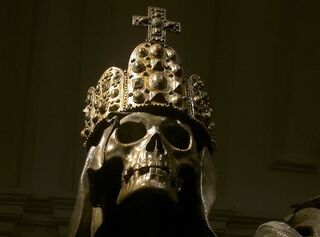Trust
To Trust a Vaccine? What the Skeptical Mozarts Learned: 2
Part 2: How the anti-vaxing Mozarts came to rue their decision.
Posted December 29, 2020
In 1764, father Leopold Mozart denied his son Wolfgang Amadeus Mozart a 98.5% safe vaccine against smallpox. What was the result? Three years later the world’s greatest prodigy contracted a severe case of the deadly disease. And just as the White House served as a venue for COVID super-spreader events during the presidency of Donald Trump, so the court palace and especially the crypt of the Holy Roman Empress, Maria Teresa, in Vienna, was an epicenter for the spread of smallpox.
In October 1767, the Mozarts went from Salzburg to Vienna, hoping to cash in on the festivities planned for the wedding of sixteen-year-old Princess Maria Josepha, one of the many daughters of Maria Theresa. But shortly before the nuptials, the princess died of smallpox, and she was not alone among Habsburg royalty. Her father, Emperor Francis I, had succumbed to the disease as did four of his siblings. Francis’s son and successor, Joseph II, caught it but survived, as did his wife, Maria Theresa, though she was left visibly scarred. Joseph’s first two wives died of the pox as well, as did three of Maria Theresa’s children, including Maria Josepha. Why so many deaths from one disease in one family in less than a decade? Super-spreader events? More likely a super-spreader place.

French kings were traditionally buried at the basilica of St. Denis north of Paris; English royalty in Westminster abbey. For the Habsburg emperors, the family vault was in the center of Vienna, in the Church of the Capuchins, and a stone’s throw from where the Mozarts had taken up lodging. In the Imperial Crypt rested the corpses of smallpox victims Emperor Francis and two of his children, as well the two deceased wives of Joseph II, the last with casket closed but still unsealed. In this case, not only rotting corpses, but also ecclesiastical hangings and furnishing had the capacity to retain microbial pathogens of variola—the Latin name for the smallpox virus. [1]

Within months of the Mozarts' arrival in Vienna, another royal daughter, Maria Elizabeth, contracted smallpox and was so disfigured that she entered a convent. Given these losses, Maria Theresa became a convert to vaccination. She hired a physician with experience in smallpox inoculation, set up trials on “charity” children, and then, when confident of the safety of the vaccine process, had her remaining younger children inoculated, including Marie-Antoinette, future queen of France.[2] As far as can be determined, none contracted smallpox.
But the musical Mozarts were left dangling. Just as today, when almost all in-person performances have stopped, musicians were then out of work while the virus raged. “In all Vienna, the talk was of nothing but the smallpox. If 10 children were listed on the notice of deaths, 9 of them had died of smallpox.”[3] Hastily, Leopold Mozart packed up and headed for nearby but more rural Czechia. All in vain—on Oct. 26, 1767, prodigy Wolfgang presented with symptoms of the pox.
“At ten o’clock,” said Leopold of that evening, “little Wolfgang was complaining of his eyes” [he was not able to see for nine days].[4] “I noticed that his head was warm, that his cheeks were hot and very red, but that his hands were as cold as ice. Moreover, his pulse was not right. Towards evening he began to rave, and all night long and during the morning of the 28th he was delirious. ... On the 29th, some small, red spots were visible, but we all doubted if this was smallpox, since he was no longer very ill. ... On the 30th and 31st the smallpox came out completely. As soon as this happened, the fever disappeared altogether and, thank God, he was still right in his head.”[5] Mozart had survived, but not unscathed.
Today, victims of COVID-19 complain of its long-term effects. The virus often causes not only lasting respiratory difficulty but also, among other things, persistent kidney and heart problems.[6] Similarly, there is some connection between coronary damage and smallpox.[7] Wolfgang Amadeus Mozart died unexpectedly on Dec. 5, 1791, not of poisoning by a jealous rival, but of renal failure and cardiomyopathy.[8] The point here is not to claim that Mozart’s premature death was the result of the long-term effects of smallpox—he also had had heart-debilitating rheumatic fever and other serious illness as a child. But only to suggest that a severe bout of smallpox did not make his constitution stronger. In addition, Mozart’s face was left with scars that he carried to the grave. As his sister Nannerl wrote to a friend after Mozart’s death. “I am also enclosing an engraving which was made during our stay in Paris (see Figure 1 from Part 1). From this you can see how handsome my brother was as a child. It was only after the small-pox that he became so disfigured.”[9]
The moral of the story: follow the numbers. In Mozart’s Europe, your chances of dying from smallpox if uninoculated was roughly 15-20%, and if inoculated, even with small amounts of smallpox itself, only about 1-1.5%. Leopold Mozart and his family would have benefited from doing precisely what those “impertinent” Parisians had urged him to do in 1763: get inoculated!
I am the author of The Hidden Habits of Genius. Follow me at craigwrightgeniusmusic.net.
References
[1] See Bennett, War Against Smallpox, pp. 12 and 18.
[2] Bennett, War Against Smallpox, pp., 51-52.
[3] Letter of November 10, 1767, Salzburg Mozarteum, online edition, No. No. BD 121.
[4] Otto Erich Deutsch, Mozart: A Documentary Biography, trans Eric Blom et al. (Stanford, 1965), p. 494.
[5] Letter of November 10, 1767, Salzburg Mozarteum, online edition, No. BD 121.
[6] See, for example, C. John Sperati, M.D., “Coronavirus: Kidney Damage Caused by COVID-19,” Johns Hopkins Medicine: Health, accessed November 18, 2020 https://www.hopkinsmedicine.org/health/conditions-and-diseases/coronavi…; and Richard C. Becker, “Anticipating long-term cardiovascular effects from COVID-19,” PMA U.S National Library of Medicine National Institutes of Health, accessed November 18, 2020 https://www.ncbi.nlm.nih.gov/pmc/articles/PMC7467860/#:~:text=The%20ove….
[7] [1] Small amounts of the live virus in the smallpox vaccine caused coronary events in a small number of cases. See, “Cardiac Adverse Events Following Smallpox Vaccinations --- United States, 2003,” in Morbidity and Mortality Weekly Report of the Center for Disease Control and Prevention, March 28, 2003, 52(12): 248-250; and “Smallpox: Side Effects of Vaccination,” Center for Disease Control and Prevention, accessed November 16, 2020, https://www.cdc.gov/smallpox/vaccine-basics/vaccination-effects.html
[8] A good overview of the possible causes of Mozart’s death is Edward N. Guillery, “Did Mozart Die of Kidney Disease?,” Journal of the American Society of Nephrology, 1992; 2:1671-1676.
[9] Deutsch, Mozart: A Documentary Biography, p. 493.


